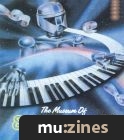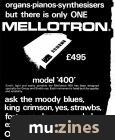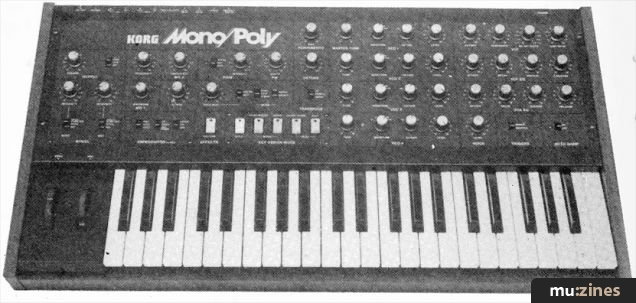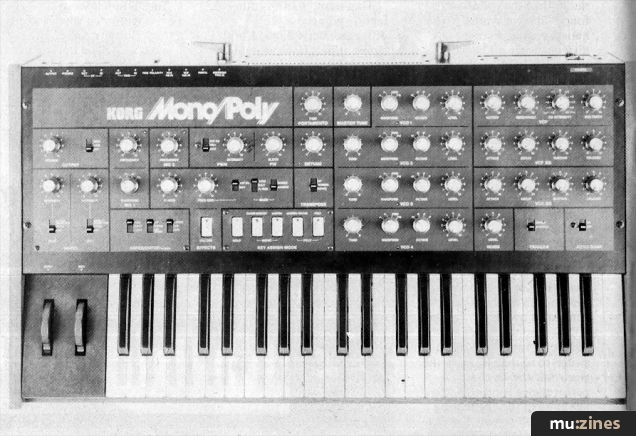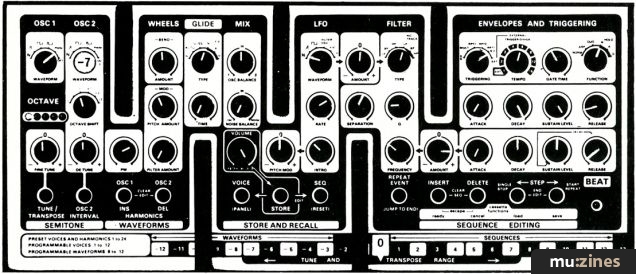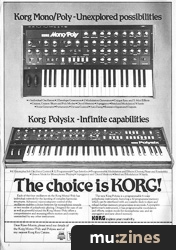Magazine Archive
Home -> Magazines -> Issues -> Articles in this issue -> View
Playing The Game | |
Korg Mono/PolyArticle from Music Technology, November 1988 | |
As analogue synthesis enjoys a return to popularity, yesterday's synths are becoming regular topics of conversation. Rob Norman rediscovers voltage control.
On the eve of the arrival of the DX7, Korg unveiled an analogue synthesiser that attempted to combine features of mono and polysynths in a unique performance instrument.

MEET THE MONO/POLY: one of the last generation of synthesisers with that "mixing-desk-with-a-keyboard" look. A frightening array of potentiometers and rotary switches above a 44-note keyboard dates this machine to those days when the data entry slider was but a wicked gleam in a design engineer's eye. Programming was quick and easy, "interactive" as the jargon now has it. Daunting as all those knobs appeared, however, they were arranged in such a way that the full power of the instrument is very accessible.
If you were looking for a synthesiser just before the release of the first DX7, you might well have been tempted to invest around £750 in a Korg Mono/Poly. It was the first synth I actually owned, going halves on it with a friend who had some recording gear. Up until then, I had only spent a few hours with a borrowed Korg MS20 and an SCI Pro One. The former was altogether too profound for a novice, while trying to persuade the Pro One to make a sound at all was like trying to knit yogurt: one injudicious twist of a knob and the beast would clam up. By contrast, right from my introduction to the Mono/Poly I felt I was making music, instead of amusing but crass noises. Five years later, the instrument is still capable of surprising me if I'm prepared to give it the time and concentration it deserves.
It's a curious name, Mono/Poly, but it's a good indication of the design philosophy of the instrument. The basis of its layout is the same as the old Minimoog (VCO, VCF, VCA). It is distinguished, though, by having four voltage-controlled oscillators which can be mixed in unison or which can be individually assigned to up to four different keys so that two-, three- or four-note chords can be played. Each VCO provides triangle, sawtooth and pulse-width modulated waveforms. Pulse-width for all VCOs is controlled with a single pot, and can be varied between 50-0%. Pulse-width modulation can be selected independently for each VCO. There is a PWM intensity pot and a three-position switch enabling the PWM to be clocked by either of the two LFOs or to be swept by the VCF envelope generator. Tuning, level and octave footage for each VCO are also independently variable. All these parameters, while taking up a lot of space on the console, allow subtle control over what is an extremely rich harmonic output.
It is a third, to my mind invaluable, option for key assign that is the Mono/Poly's secret: Unison/Share. This assigns the VCOs dynamically according to how many keys are played. For instance, if a single key is played, all four VCOs are assigned to it. When two keys are played, two VCOs are assigned to each. When three keys are played, one VCO is assigned to each and one remains silent until a fourth key is played. This allows you to change instantly between chord accompaniment and soloing without changing your master volume level. An LED for each VCO gives a useful indication of which ones are in use at any one time (at least during the Key On phases of the envelope). Unless you're actively looking for bizarre effects, all the oscillators should be tuned to the same pitch.
Of course, the Mono/Poly is not a true four-note polyphonic instrument; there is but a single envelope generator for each of the VCA and VCF. This means that there are no independent envelopes for notes that overlap one another, but a switch allows you to select single or multiple triggering modes which partially compensates for this. In Multi mode each new note re-initialises the EGs, while in Single mode a new note beginning before the end of the previous one will sound but will continue the envelope cycle triggered by the first. For fast lead playing, Multi mode is extremely useful and its presence marks an improvement over earlier Korgs, (notably the Sigma). Interestingly, the Minimoog itself was only fitted with a multiple filter trigger to special order, the majority having single-trigger filters.
Single mode comes in useful when crisp attacks are required - when chopping out staccato chords, for example. In Multi mode I find attacks tend to stutter a little, a phenomenon I can only attribute to my fingers varying wildly in length. These inaccuracies in timing are exaggerated when the attack of a single chord is being re-triggered.
"The Performance section of the Mono/Poly is about the most comprehensive I've seen on any instrument, ancient or modern."
The envelopes are standard of the ADSR format, and one is provided for each of the VCA and the VCF. This is useful in producing the more complex and imitative effects.

THE MANUAL DESCRIBES the Mono/Poly as a lead synthesiser - in my book what makes a lead synth is its "performance" section. And the Performance section of the Mono/Poly is about the most comprehensive I've seen on any instrument, ancient or modern. To the left of the keyboard are two wheels similar to, and no doubt influenced by, the Moog design. The left-hand wheel is for pitch-bending and is centre detented. A three-position switch gives pitch-bend for all VCOs, independent bend for VCO 1 and VCF Cutoff. The right-hand (modulation) wheel can also be assigned these three parameters by way of its own three-way switch. There is also an intensity pot for each wheel, which adds to the flexibility of this section. Triangle, sawtooth, reverse sawtooth and square waveforms are available for modulation effects. A sample-and-hold waveform would have been nice, but then the Minimoog didn't have it either...
Of the systems that exist for adding expression to a melody line using that "spare" hand, I feel Roland have the best arrangement - a sprung lever with left-right pitch-bend and forward modulation. The pitch-bending is perfectly logical as it follows the direction of the keyboard but the modulation is rather indeterminate. The twin wheel system invented by Moog is far better for introducing modulation, but for pitch-bend I'd say it's less so. With the Mono/Poly I've found it's best to forgo pitch-bend altogether and assign VCF cutoff to the pitch-bend wheel. Depending on how you set the VCF parameters, this can provide powerful and expressive effects. Pulling the wheel right back can make the sound disappear, the oscillator output being filtered out completely. Bringing the wheel forward can give guitar-volume-pedal type expression, and throwing it all the way forward brightens and boosts the timbre. Very acid house.
"With the oscillators mixed out, the arpeggiator can be used to trigger the filter envelopes in an endless variety of semi-random effects."
The arpeggiator is a (much lamented) device that was over-used in the mid-'70s by the likes of Tangerine Dream, Klaus Schulze and Jean Michel Jarre - probably the main reason nobody builds them into keyboards anymore. Admittedly, next to an eight-track MIDI sequencer it seems a very restricted facility indeed, but it is capable of producing many desirable effects you'll find hard to obtain from your state-of-the-art MIDI sequencer. The Mono/Poly's arpeggiator is particularly flexible and is capable of far more than any arpeggiator effects I've heard on record. Why? Firstly, it can be clocked from a dedicated LFO (MG2) or an external pulse for syncing with other analogue machines. Secondly, the arpeggios can be swept up, down or up and down over one octave, two octaves or the full range of the VCOs. One of my favourite applications is to mix out all the VCOs and turn up the VCF resonance until the filter oscillates to produce some neat (if not unique) percussive sounds. Using the arpeggiator to trigger the envelopes, an endless variety of semi-random effects can be produced, especially by introducing filter modulation clocked independently by the other LFO. In this configuration the effect is defined by up to 16 parameters. The range of sounds covers bubbling, dripping, twittering, tinkling, crackling and much in between that defies onomatopoeic description.
Selecting Poly mode means that the four VCOs are triggered one at a time in rotation. If different waveforms, registers and levels are set for each VCO, complex patterns can be created that largely get away from the mundane up and down sweep of a mono arpeggiator. The results are more like those of an old analogue sequencer, though rather more unpredictable and considerably more dynamic.
Another section of the front panel is labelled "Effects". This section controls the synthesisers cross-modulation and frequency modulation. The latter can be clocked by MG1 or swept by the VCF EG. Cross-modulation is often quoted as being useful in "fattening-up" a sound. I've always taken this as a euphemism for making your synth sound like a helicopter, but I know there are Mono/Poly users who find this section indispensable when it comes to dirty lead sounds.
Other facilities include a Hold momentary switch (which keeps the note sounding at the sustain level set by the ADSRs) and Portamento, which can give dramatic results in Poly mode. A chord memory function, whereby the shape of a chord of up to four notes can be played using single keys is also provided.
For my money the Mono/Poly is a powerful synthesiser with few compromises and one or two unique features. These allow certain effects to be created that are peculiar to this instrument. It may not have the sweetness of tone of the Minimoog, but is capable of rich, and when required, gutsy lead sounds. As far as flexibility is concerned, it's superior to the Minimoog but, as is invariably the case with these old analogue instruments, has a character of its own. You won't get the power of a Minimoog bass out of the Mono/Poly, nor will you get that distinctive Minimoog lead sound. But then. I've never seen a Minimoog with an arpeggiator.
If you want a Mono/Poly don't go to Korg. Secondhand, you can expect to pay between £100 and £200 for one that's in good nick. Although the synthesiser has been reinvented several times since the days of voltage control, few machines of any generation will give the kind of power per pound that the Mono/Poly does.
More with this topic
Total recall - Akai the old |
Total recall - Analogue heaven |
Juno Jive! - Yesteryear's Gear: Roland Juno synths |
Total recall - Cosmology |
History By Numbers - A Re-Review Of The Roland MC4 Microcomposer |
Taurus Taurus Taurus - Bass Pedals |
The Electronic Keyboard (Part 1) |
The Time Machine |
Sampling A Vintage |
Hands On: Moog MiniMoog |
Small is Beautiful - YESTERYEAR'S GEAR: fender duo sonic guitar |
The Games People Played - YESTERYEAR'S GEAR: Olympic drums |
Browse by Topic:
Vintage Instruments
Also featuring gear in this article
Korg Mono/Poly
(EMM Apr 82)
Lead On
(ES Mar 84)
Patchwork
(EMM Jan 85)
...and 4 more Patchwork articles... (Show these)
Browse category: Synthesizer > Korg
Publisher: Music Technology - Music Maker Publications (UK), Future Publishing.
The current copyright owner/s of this content may differ from the originally published copyright notice.
More details on copyright ownership...
Retrospective (Gear) by Rob Norman
Help Support The Things You Love
mu:zines is the result of thousands of hours of effort, and will require many thousands more going forward to reach our goals of getting all this content online.
If you value this resource, you can support this project - it really helps!
Donations for April 2024
Issues donated this month: 0
New issues that have been donated or scanned for us this month.
Funds donated this month: £7.00
All donations and support are gratefully appreciated - thank you.
Magazines Needed - Can You Help?
Do you have any of these magazine issues?
If so, and you can donate, lend or scan them to help complete our archive, please get in touch via the Contribute page - thanks!





